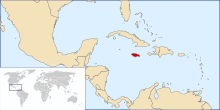Urania sloanus
| Urania sloanus | |
|---|---|

| |
| 1829 illustration of the now extinct Urania sloanus by William Swainson | |
Extinct (c. 1894-1908)
| |
| Scientific classification | |
| Domain: | Eukaryota |
| Kingdom: | Animalia |
| Phylum: | Arthropoda |
| Class: | Insecta |
| Order: | Lepidoptera |
| Family: | Uraniidae |
| Genus: | Urania |
| Species: | †U. sloanus
|
| Binomial name | |
| †Urania sloanus (Cramer, 1779)
| |

| |
| Former range in red (Jamaica) | |
| Synonyms | |
| |
Urania sloanus, or Sloane's urania, was a species of moth of the family Uraniidae endemic to Jamaica. It was last reported in 1894 or 1895,[1] but possibly survived until at least 1908.[2][3] The species was first described by Pieter Cramer in 1779.
The specific epithet sloanus honours Sir Hans Sloane (1660–1753),[3][4] an English collector whose collection became the foundation of the British Museum.
Description
This extinct Urania species was black with iridescent red, blue and green markings. The iridescent parts of the wings do not have pigment; as determined by optical analysis on the species Urania fulgens belonging to the same genus.[5] The color originates from refraction of light by the ribbon-like scales covering the moth's wings.
Urania sloanus is considered "the most spectacular Urania species".[1] As most species of the subfamily Uraniinae, it was a day-flying moth while most moths are active at night; its bright colors advertised, as a warning, the fact that it was also toxic. "Urania sloanus species had orange and green neon coloring spread through its wings" (Smith, 1991). These components facilitate the future discovery of the species if they are found to still be existing. The vibrant coloring makes the species easily identifiable to researchers and ecologists studying the species.
 |
 |
Extinction
Based on current knowledge of extant uraniine species, it is likely that Sloane's urania migrated between patches of host plants, after population explosions locally defoliated them. This probably required relatively large, intact areas of lowland forest.[3][6]
Habitat loss when Jamaica's lowland rainforests were cleared and converted to agricultural land during the colonial era may have contributed to its extinction, although large parts of primary forest still remain. This specific species of moths experienced a decline in their population because of a drastic change in environmental components. Like other members of the genus Urania, periodic swarms of moths were separated by years of great scarcity.[1][3] The U. sloanus species faced significant threats that imposed less than sustainable environments for the species survival. U. sloanus species experienced the loss of their main larval host through habitat destruction this was directly linked to abrupt agricultural changes, hurricanes, and other natural disasters (Nazari, 2016). As the question of why did this species become extinct is further examined, we can conclude that the species was forced into unsustainable and unadaptable conditions that would inevitably lead to a loss in the overall population and survival rates of the species.
References
- ^ a b c Lees, D.C. & Smith, N.G. (1991). "Foodplants of the Uraniinae (Uraniinae) and their Systematic, Evolutionary and Ecological Significance". Journal of the Lepidopterists' Society. 45: 297-347. Retrieved August 3, 2015.
- ^ Vinciguerra, R. (2009). "Osservazioni su Urania sloanus (Cramer, 1779) (Lepidoptera: Uraniidae)". SHILAP Revista de Lepidopterología. 37 (147): 1-6.
- ^ a b c d Lees, D.C. (2010). "Urania sloanus Natural History Museum Species of the Day", April 16, 2010. Archived from the original February 21, 2015.
- ^ The Century Dictionary by The Century Company.Available online.
- ^ Prum, R.O. Quinn T. & Torres, R.H. (2006). "Anatomically diverse butterfly scales all produce structural colours by coherent scattering". The Journal of Experimental Biology. 209, 748-765 doi:10.1242/jeb.02051
- ^ (2004) Urania sloanus in The Titian Peale Butterfly and Moth Collection of The Academy of Natural Sciences. Retrieved October 6, 2007.
7. Nazari, V., Schmidt, B. C., Prosser, S., & Hebert, P. D. N. (2016). Century-Old DNA Barcodes \ Reveal Phylogenetic Placement of the Extinct Jamaican Sunset Moth, Urania sloanus Cramer (Lepidoptera: Uraniidae). PLOS ONE, 11(10), e0164405. https://doi.org/10.1371/journal.pone.0164405
8. Smith, N. (1991). FOOD PLANT ASSOCIATIONS OF THE URANIINAE (URANIIDAE) AND THEIR SYSTEM A TIC, EVOLUTIONARY, AND ECOLOGICAL SIGNIFICANCE. Journal of the Lepidopterists’ SOciety, 45(4), 296–347. https://images.peabody.yale.edu/lepsoc/jls/1990s/1991/1991-45(4)296-Lees.pdf
External links
 Media related to Urania sloanus at Wikimedia Commons
Media related to Urania sloanus at Wikimedia Commons Data related to Urania at Wikispecies
Data related to Urania at Wikispecies- Urania sloanus Peale specimen from the Academy of Natural Sciences general collection. Contains a photo (with scale) of a specimen collected by Titian R. Peale.
